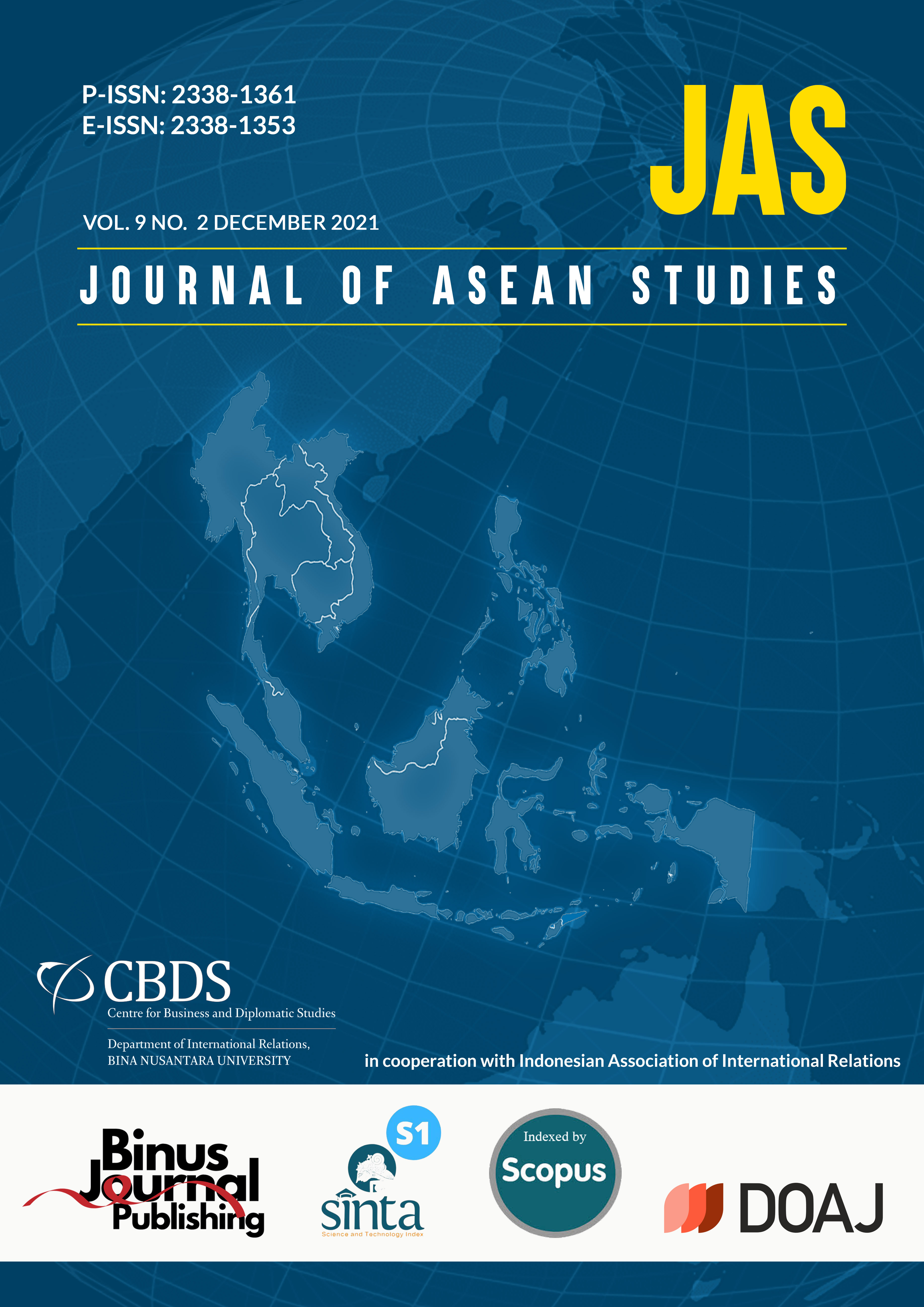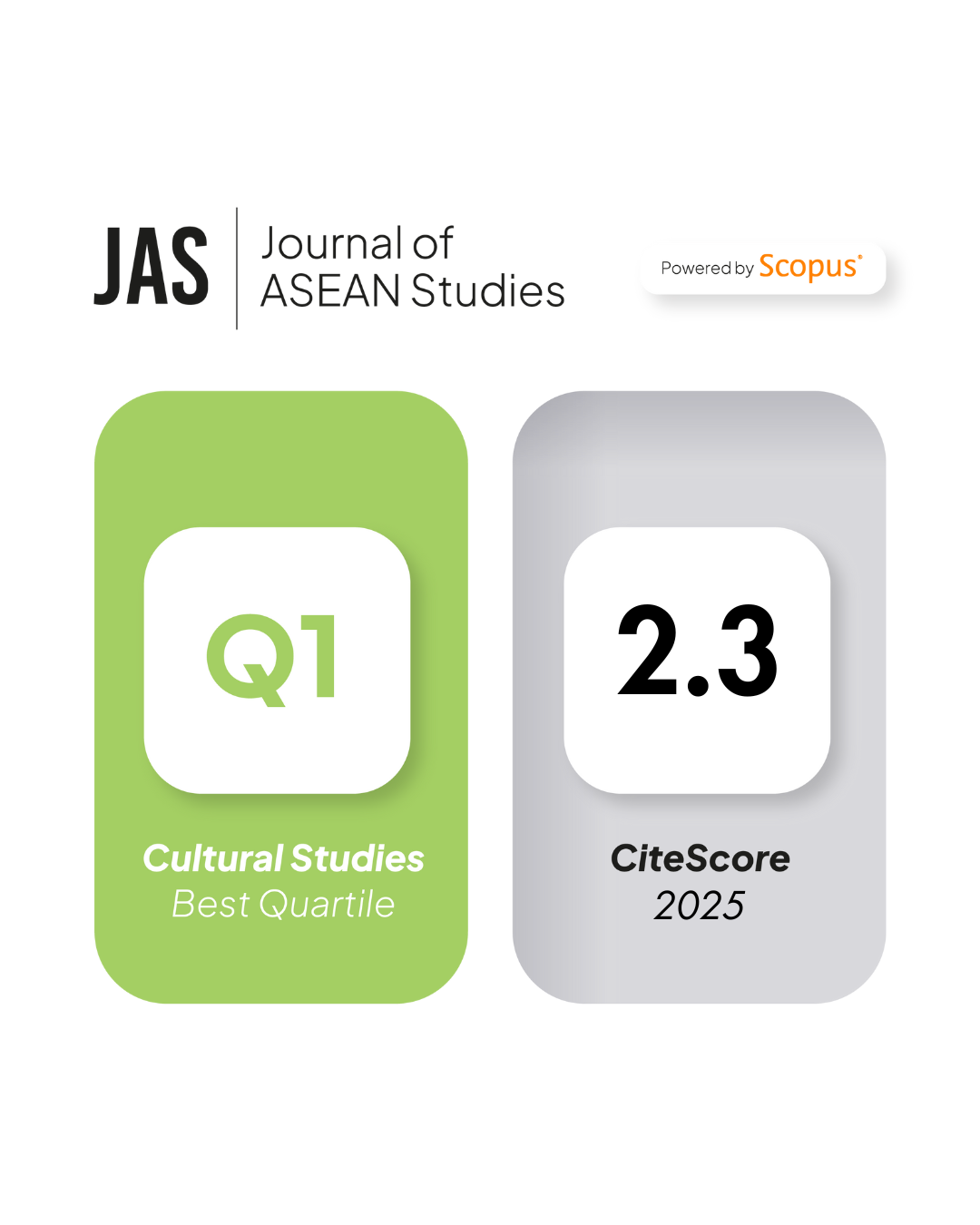THE ROLE OF THE ASEAN SUMMIT IN THE ASEAN ECONOMIC DISPUTE SETTLEMENT
DOI:
https://doi.org/10.21512/jas.v9i2.7771Keywords:
ASEAN Summit, ASEAN dispute settlement mechanism, unresolved disputesAbstract
Like the World Trade Organization (WTO) Dispute Settlement Mechanism, the Association of South-East Asian Nations Enhanced Dispute Settlement Mechanism (ASEAN EDSM) recognizes trade countermeasures in the event of non-compliance with rulings made by the Panel and Appellate Body. However, the injured party sometimes has to deal with stumbling blocks in requesting an authorized trade countermeasure. The pitfall highlights the consequences if the dispute is unresolved. Meanwhile, ASEAN recognizes a procedure to allow the disputant parties to render unresolved disputes to the ASEAN Summit according to Article 26 of the ASEAN Charter. Moreover, if the non-implementation of the ASEAN dispute settlement decision affects the injured party, this party can submit the issue to the ASEAN Summit according to Article 27(2) of the ASEAN Charter. This research investigates whether the role of the ASEAN Summit can be a solution for the post-adjudication issue in the ASEAN EDSM. The research methods consist of a literature review and close reading of the Article 26 and 27 of the ASEAN Charter. The result shows that the intervention of the ASEAN Summit to the post-adjudication of ASEAN EDSM is likely to apply political solutions that would, in turn, make legal decisions subject to politically driven scrutiny. However, ASEAN commits that any economic disputes must be resolved to ensure economic stability in the ASEAN.
References
Asian Development Bank (ADB). (2019, April 12). ASIAN Development Outlook 2019: Strengthening Disaster Resilience xii. https://www.adb.org/sites/default/files/publication/492711/ado2019.pdf
ASEAN. (2004). Terms of Reference of the ASEAN-China Joint Working Group on the Implementation of the Declaration on the Conduct of Parties in the South China Sea. Retrieved October 12, 2021, from https://asean.org/terms-of-reference-of-the-asean-china-joint-working-group-on-the-implementation-of-the-declaration-on-the-conduct-of-parties-in-the-south-china-sea-2/
Bagwel, K., Mavroidis, P. C., & Staiger, R. W. (2004). The Case for Tradable Remedies in WTO Dispute Settlement. Washington DC: World Bank.
Beckman, R., Bernard, L., Pan, H., Li, T., & Yusran, R. (2016). Promoting Compliance: The Role of Dispute Settlement and Monitoring Mechanism in ASEAN Instruments. Cambridge: Cambridge University Press.
Bronkers, M., & Van den Brock, N. (2006). Financial compensation in the WTO: Improving remedies of the WTO dispute settlement. In D. Georgiev & K. Van der Borght (Eds.), Reform and Development of the WTO Dispute Settlement System (p. 50). London: Cameron May.
Capucio, C. (2016). Implementing decisions of the WTO dispute settlement in Brazil: Is there a place for transparency and participation? Revista Brasileira de Politica Internacional, 59(1), 1-16. https://doi.org/10.1590/0034-7329201600108
Chachavalpongpun, P. (2013). Thai-Cambodian conflict: The failure of ASEAN's dispute settlement mechanisms. Asian Journal of Peacebuilding, 1(1), 65-86. http://dx.doi.org/10.18588/201305.000005
Cho, S. (2004). The nature of remedies in International trade law. The University of Pittsburgh Law Review, 65, 763 - 774.
Desierto, D. A. (2011). ASEAN's constitutionalization of the International Law: Challenges to evolution under the new ASEAN Charter. Columbia Journal of Transnational Law, 49, 268 - 320.
Druce, S. C. & Baikoeni, E. Y. (2016). Circumventing conflict: The Indonesia-Malaysia Ambalat block dispute. In M. Oishi (Eds.), Contemporary Conflicts in Southeast Asia, Asia in Transition (p. 149). Singapore: Springer Science+Business.
Ewing-Chow, M. & Yusran, R. (2018). The ASEAN trade dispute settlement mechanism. In R. Howse, E. Ruiz-Fabri, G. Ulfstein, & M. Zang (Eds.), The Legitimacy of International Trade Court and Tribunals (p. 383). Cambridge: Cambridge University Press.
Guzman, A. T. & Simmons, B. A. (2005). Power plays and capacity constraints: The selection of defendants in World Trade Organization disputes. Journal of Legal Studies, 34, 557 - 598.
Ha, H. T. & Chalermpalanupap, T. (2018). The ASEAN Summit: Origin and evolution. ASEAN Matter, (2), 1.
Horlick, G. N. (2002). Problems with the compliance structure of the WTO dispute resolution process. In D. L. Kennedy, & J. D. Southwick (Eds.), The Political Economy of International Trade Law: Essay in Honor of Robert E. Hudec (p. 636). Cambridge: Cambridge University Press.
Inama, S. & Sim, E. W. (2015). The Foundation of the ASEAN Economic Community. Cambridge: Cambridge University Press.
Indonesia - Recourse to Article 22.2. of the DSU in the U.S. - Clove Cigarettes Dispute: Request for Consultation by the E.U. (June 19, 2014).
Jenne, N. (2017). Managing territorial disputes in Southeast Asia: Is there more than the South China Sea? Journal of Current Southeast Asian Affairs, 36(3), 35 - 61. https://doi.org/10.1177%2F186810341703600302
Lau, T. (2006). Distinguishing fiction from reality: The ASEAN free trade Area and implications for the Global Auto Industry. Management and Marketing Faculty Publications, 8, 1-25.
Limenta, M. (2017). WTO Retaliation: Effectiveness and Purpose. Oxford/Portland: Hart Publishing.
Mavroidis, P. C. (2000). Remedies in the WTO legal system: Between a rock and a hard place. European Journal of International Law, 11(4), 763 - 813. https://doi.org/10.1093/ejil/11.4.763
Mercurio, B. (2009). Why compensation cannot replace trade retaliation in the WTO dispute settlement understanding. World Trade Review, 8(2), 315-338. https://doi.org/10.1017/S1474745609004273
P.H. has legal options at WTO and ASEAN over cigarette tax case vs Thailand. (2016, January 24). Manila Bulletin. https://www.asiansil.org/ph-has-legal-options-at-wto-and-ASEAN-over-cigarette-tax-case-vs-Thailand-manila-bulletin-24-January-2016/
Phan, H. D. (2013). Towards a rules-based ASEAN: The protocol to the ASEAN Charter on dispute settlement mechanism. Arbitration Law Review, 5, 254 - 276.
Piris, J. C. & Woon, W. (2015). Towards a Rules-Based Community: An ASEAN Legal Service. Cambridge: Cambridge University Press.
Puig, G. V. & Tat, L. T. (2015). Problems with the ASEAN free trade area dispute settlement mechanism and solution for the ASEAN Economic Community. Journal of World Trade, 49(2), 277-308.
The ASEAN Secretariat. (2018, December 12). ASEAN Key Figures 2018. https://www.ASEANstats.org/wp-content/uploads/2018/12/ASEAN-Key-Figures-2018.pdf
Shaffer, G. C. (2006). The challenges of WTO law: Strategies for developing country adaption. World Trade Review, 5(2), 177-198.
Shanin, M. (2011). WTO dispute settlement for middle-income developing country: The situation in Egypt. In G. C. Shaffer & R. M. Ortiz (Eds.), The Dispute Settlement at the WTO: The Developing Country Experience (pp. 282-284). Cambridge: Cambridge Press University.
Shimizu, K. (2011). The ASEAN Charter and the ASEAN Economic Community. Economy Journal of Hokkaido University, 40, 73 - 87.
Sim, E. W. (2014). The outsourcing of legal and institutions by the ASEAN Economic Community. Indonesian Journal of International & Comparative Law, 1(1), 314 - 331.
Siong, D. C. (2011). Trade dispute settlement within ASEAN. In Y. Y. Lee (Ed.), ASEAN Matter! Reflecting on the Association of Southeast Asian Nations (p. 116). Singapore: NUS Press.
Soeparna, I. (2019). ASEAN investment dispute settlement: A challenge to the ASEAN enhanced dispute settlement mechanism. In Y. J. Ma (Ed.), Chinese (Taiwan) Yearbook of International Law and Affairs (p. 298). Leiden/Boston: Brill Nijhoff.
Tan, E. K. (2008). The ASEAN Charter as "Legs to Go Places:" Ideational norms and pragmatic legalism in community building in Southeast Asia. In Singapore Yearbook of International Law (pp. 171 - 187). Singapore: National University of Singapore.
Thailand – Customs and Fiscal Measures on Cigarettes form the Philippines: Second Recourse to Article 21.5 of the DSU by the Philippines (2019).
Thailand - Customs and Fiscal Measures on Cigarettes from the Philippines: Recourse to Article 21.5 of the DSU by the Philippines (2018).
Thailand - Customs and Fiscal Measures on Cigarettes from the Philippines: Communication from Thailand (2020).
Thailand - Customs and Fiscal Measures on Cigarettes from the Philippines: Recourse to Article 22.2 of the DSU (2020).
Thailand - Customs and Fiscal Measures on Cigarettes from the Phillippines (2011).
Toohey, L. (2011). When "failure" indicates success: Understanding trade dispute between ASEAN members. In R. P. Buckley, R. W. Hu, & W. D. Arner (Eds.), The East Asian Economic Integration: Law, Trade and Finance (p. 165). Northampton: Edwar Elgar.
Udomjitpittaya, W. & Fitriana, Z. M. (2019). ASEAN vs WTO DSM: Overcoming jurisdiction issues to encourage regional trade agreement's system efficacy. Yurika, 35(2), 407 - 428. http://dx.doi.org/10.20473/ydk.v35i2.16876
United States-Measures Affecting the Cross-Border Supply of Gambling and Betting Service (US-Gambling) (2007).
Vergano, P. R. (2009). The ASEAN Dispute Settlement Mechanism and Its Role in a Rules-BAsed Community: Overview and Critical Comparison. Tokyo: ASIAN International Economic Law Network, University of Tokyo.
Wan, C. K. (1997). ASEAN in the new millennium. In C. Yue, & m. Pacini (Eds.), ASEAN in the New ASIA: Issue & Trends (pp. 147 - 149). Singapore: ISEAS - Yusof Ishak Institute.
Wignaraja, G. (2012). Engaging Small and Medium Enterprise in Production Network: Firm-Level Analysis of Five ASEAN Economies. Tokyo: ASIAN Development Bank Institute.
Woon, W. (2016). The ASEAN Charter. Singapore: National University Singapore Press.
Downloads
Published
How to Cite
Issue
Section
License
Copyright (c) 2021 Intan Soeparna

This work is licensed under a Creative Commons Attribution-NonCommercial 4.0 International License.






















